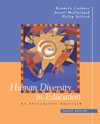 |  Human Diversity in Education: An Integrative Approach, 4/e Kenneth H. Cushner,
Kent State University, Kent
Averil McClelland,
Kent State University, Kent
Philip Safford,
Case Western Reserve University
Creating Developmentally Appropriate Classrooms: The Importance of Age and Developmental Status
Definitions| Cognitive structures | The ways in which individuals organize or scaffold knowledge so as to learn, remember, think, and otherwise use it.
(See 322)
|  |  |  | | Constructivist perspective | The belief that all knowledge is built, or "constructed," by individual learners; it is thus important when teaching and learning new knowledge to connect it to knowledge already known.
(See 322)
|  |  |  | | Developmentally appropriate practice (DAP) | Instructional practices that are organized and designed on the basis of the age and development of the student.
(See 319)
|  |  |  | | Nature versus nurture debate | A long-standing argument about which is more important in the outcome of an individual's development: a set of inborn and immutable characteristics, or education, that is to say, learning.
(See 330)
|
|



 2003 McGraw-Hill Higher Education
2003 McGraw-Hill Higher Education